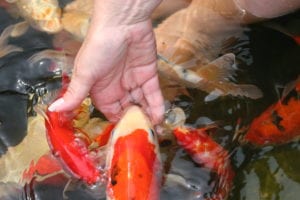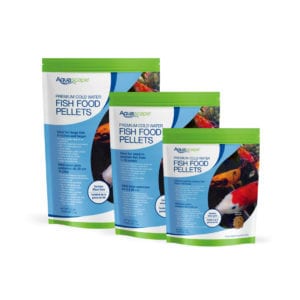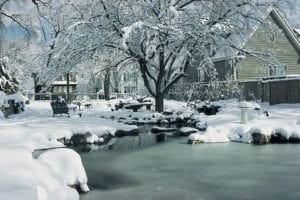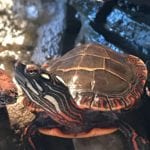When to Stop Feeding Pond Fish for Winter
Fall is a finicky season.Temperatures in early and mid October often sway from summer-like highs in the 80s to chilly lows in the 40s. This all-over-the-place weather can confuse pond owners who want to prep for the changing seasons.
Here are a few tips to help your fish through a Pennsylvania/Maryland autumn:
At a Glance: Fall Pond Fish Care
- Continue to feed your fish as much food as they will eat for as long as the weather stays warm.
- Stick with summer food until the weather is consistently cool.
- Switch to a cold water food when temperatures start to feel consistently fall-like and your fish seem less active.
- As the weather cools, gradually reduce the number of feedings until your water temperature is consistently below 55 degrees. Then stop feeding completely until spring.
Warm Fall: Pack in the Nutrients
 Fall officially starts Sept. 22. But in Pennsylvania and Maryland, the thermometer often begs to differ.
Fall officially starts Sept. 22. But in Pennsylvania and Maryland, the thermometer often begs to differ.
Take advantage of summer-like temperatures – highs in the upper 70s or 80s – to help your fish pack in the nutrients they'll need to survive the winter.
Fish like koi and goldfish don't technically hibernate. Instead, they go into a semi-dormant state called torpor, during which their metabolisms slow, their activity levels drop and they stop eating all together. You have an opportunity in early fall, then, to help your finned friends get as much food in their bellies as possible before they make the seasonal switch.
Feed your fish as much as they're willing to eat during these warm autumn days. Give them some Koi Krunchies, watermelon, orange slices or other protein- and vitamin-packed snacks, on top of their regular summer food.
As always, only feed your fish as much as they'll eat in about five minutes, and limit the number of feedings to no more than about three times per day. But as long as your fish are eating what you feed them, go ahead and enjoy these last few weeks of bonding with your finned friends.
Cool Fall: Switch to Cold Water Food
 Your pond fish's nutritional needs will start to change as "real" fall weather sets in.
Your pond fish's nutritional needs will start to change as "real" fall weather sets in.
Help them adapt to the gradually cooling water temperatures by switching to cold-water fish food. This food, available at Splash, has less protein and more wheat germ than summer formulas. Your fish can easily digest this transitional food as their metabolisms wind down for the season.
Switch to cold water food when temperatures start to feel consistently cool but your water is still usually above 55 degrees. Keep an eye on how much your fish consume in about a five-minute period, and gradually cut back the number and size of feedings as they seem less interested in eating.
Cold Fall: Stop Feeding Completely
The warm weather will eventually end – and your fish's need for food will end with it.
Stop feeding your fish when the water temperature is consistently below about 55 degrees. They might still act hungry for a bit after you cut off their food supply, but don't give in if the weather is cold every day. Cold water means cold fish, which means slowed-down metabolisms. Any extra food you give them will consequently sit ignored in your pond – bad for water quality – or in your fish's stomachs, which is bad for their health.
Don't worry about your fish going hungry if you have a warm day in the middle of the late fall or winter. They can get any nutrients they might need from bugs and other life in your pond.
Can My Fish Stay Outside All Winter?

Koi, goldfish and other common pond fish can stay happy in a properly designed pond – meaning one that's at least 24 inches – all winter long throughout Pennsylvania and most other U.S. climates.
Thanks to their ability to go enter the semi-dormant torpor state, you don't need to feed your fish in cold temperatures, but you do need to make sure their water continues to receive ample aeration. Disturbing the water surface with a waterfall or an aerator helps to remove carbon dioxide and keep oxygen levels high. Consider installing an aerator, especially if you turn off your waterfall for the season – and keep a hole open in frozen-over ponds. An aerator is more effective than a pond de-icer or pond heater and it costs much less to run.
Fun Facts about Winter Pond Life
- Fish aren't the only animals that go into torpor. Hummingbirds, bats, bears and lots of other species also enter this semi-dormant state. Some go into torpor during cold weather, when resources are scarce. Others enter torpor for short periods of time every day as a way to conserve energy.
- Bears do not hibernate, contrary to popular belief. They instead go into torpor in much the same way fish do. True hibernators sleep entirely through the winter, while most species of bears wake up periodically throughout the season.
- Many frogs – including the bullfrogs you might see be your pond – go into full hibernation in the winter. Some aquatic species lie underwater for much of the season. Some land-dwelling species actually form ice crystals throughout parts of their bodies and appear dead until they thaw out in the spring.
- Turtles have a variety of ways to survive the winter, depending on the species. Painted turtles – which you might see in our indoor pond at Splash – are among the most extreme winter survivors. These pond dwellers spend the cold months under the ice and can endure sub-zero temperatures and low oxygen levels for remarkably long periods of time. So if you see a turtle under the ice, don't worry – it will probably pop back to the surface come springtime.

Related Links
What Do Fish Do All Winter?
What Do Frogs Do All Winter?
4 Tips for Fall & Winter Pond Care
How to Make a Hole in Pond Ice
When Should I Stop Feeding My Fish for the Winter?
How Often Should I Feed My Fish?
The Ultimate Guide to Pond Fish Care
schillersains1999.blogspot.com
Source: https://splashsupplyco.com/fall-fish-care-when-to-switch-to-cold-water-food/
0 Response to "When to Stop Feeding Pond Fish for Winter"
Post a Comment